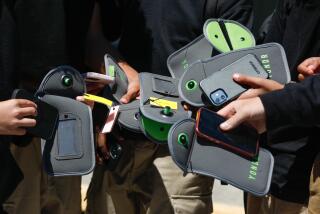At this O.C. middle school, kids can’t use cellphones at lunch. The result? They talk
Corona del Mar Middle School Principal Rebecca Gogel stood a few feet from a paper sign proclaiming no cellphone use when she saw a boy, head down, tapping away on his phone during Wednesday’s lunch break.
At other middle and high school campuses in the Newport-Mesa Unified School District, that wouldn’t be a problem or even unusual.
But at CdM Middle, it was both.
The campus is a few weeks into a new policy that’s proving to be revolutionary: no student cellphone use during lunch, except in designated areas like the front office.
School officials say the ban is needed to keep kids away from their electronic devices and stop their constant texting and social-media use.
And when they’re not face-down in their screens, they’re being kids — talking to one another, laughing and, most notably, interacting face-to-face.
Gogel walked over to the cellphone-using boy and confiscated his device. Later, she reminded another girl to put hers away.
“Re-learning is hard,” Gogel said of the rule, noting that the eighth-graders who were not subject to it last year are now having to get used to it. For students, grabbing their phones is like muscle memory, she said.
A year ago, Gogel said, lunchtime would have looked different. Most of the kids were glued to their phones, not interacting in person nearly as much, or texting people within talking distance. Others could be seen surrounding a phone. Kids without a phone felt left out.
But, save for a few exceptions, Wednesday’s 841 middle-schoolers — an estimated 95% of whom have cellphones — were obeying the rule, which came about after discussions from teachers and has caused some PTA parents to applaud.
School officials noted that CdM Middle isn’t completely cellphone-free. The devices are routinely used in classrooms to supplement educational activities. But, like during lunch, they’re regulated, placed in “parking lots” — depositories — and taken out at educationally appropriate times.
Students can use their phones during passing periods, though it’s often just to check the time. Gogel said CdM Middle is installing a large public clock to fix that problem.
Andi Racunas has noted a social improvement in her 12-year-old daughter, Brooklyn, a seventh-grader at CdM Middle. She was initially worried about her daughter’s ability to meet kids at her new school.
But when CdM Middle started and Brooklyn couldn’t turn to her phone as a distraction during lunch, she found herself excited and meeting new kids, Racunas said.
For shy children, she added, phones are a crutch to avoid socializing.
“They’ll go on their phones because they’re nervous,” Racunas said.
Megan Schafer, 12, said she likes the cellphone policy, which she thinks could help curb cyberbullying and phone addiction and help her peers on their academics.
It even has helped students not bump into one another, she added, because they’re no longer walking and texting at the same time and not paying attention to their surroundings.
“We can see more of the world now without our phones,” she said with a smile.
Megan concluded that the rule is “something to get used to, but I think it’s a good thing to get used to.”
Zint writes for the Daily Pilot.
More to Read
Sign up for Essential California
The most important California stories and recommendations in your inbox every morning.
You may occasionally receive promotional content from the Los Angeles Times.











